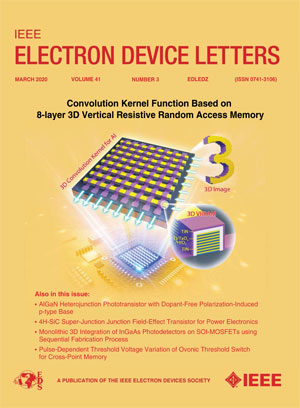Microfabricated 3D Optimized Rubidium Vapor Cell Array for Low Cost Atomic Magnetometer
IF 4.5
2区 工程技术
Q2 ENGINEERING, ELECTRICAL & ELECTRONIC
引用次数: 0
Abstract
Wearable biomagnetic field mapping with multiple-channel atomic magnetometers (AMs) requires low-cost microfabricated rubidium vapor cell arrays (RVCAs) of high performance. In this letter, an innovative microfabricated 3D RVCA with optimized polarization lifetime is proposed and demonstrated at a wafer level. To characterize the influence of vapor cell geometry on polarization lifetime, the 3D RVCA with four interconnected light-atom interaction chambers of uniform internal buffer gas pressure (0.7 amg) and various surface-to-volume ratios (17.61, 18.15, 20.95, and 27.14 cm-1) are prepared. For the first time, we utilize single-beam configuration to characterize microfabricated 3D RVCA by extrapolating to vanishing light intensity. We measure the intrinsic polarization lifetime of the four chambers within an 3D RVCA. The results indicate that decreasing the surface-to-volume ratio of the chamber in 3D RVCA at 413 K substantially improves the polarization lifetime by 129.3%. Measurements conducted across varying temperature all demonstrate that reductions in surface-to-volume ratios positively influence the enhancement of the polarization lifetime. The proposed RVCA offers critical insights for low-cost and high-performance chip-scale AM array based on microfabricated 3D atomic vapor cells.用于低成本原子磁强计的微制造3D优化铷蒸气电池阵列
采用多通道原子磁强计(AMs)进行可穿戴生物磁场测绘需要低成本、高性能的微制造铷蒸气电池阵列(RVCAs)。本文提出了一种具有优化极化寿命的新型微加工三维RVCA,并在晶圆级上进行了验证。为了表征蒸汽池几何形状对极化寿命的影响,制备了具有均匀内部缓冲气体压力(0.7 amg)和不同表面体积比(17.61,18.15,20.95和27.14 cm-1)的四个相互连接的光原子相互作用室的三维RVCA。我们首次利用单光束配置,通过外推到消失的光强度来表征微制造的3D RVCA。我们测量了三维RVCA内四个腔室的本征极化寿命。结果表明,在413 K时,减小腔室的面体积比可使极化寿命提高129.3%。在不同温度下进行的测量都表明,表面体积比的降低对极化寿命的增强有积极的影响。所提出的RVCA为基于微制造3D原子蒸汽电池的低成本和高性能芯片级AM阵列提供了重要见解。
本文章由计算机程序翻译,如有差异,请以英文原文为准。
求助全文
约1分钟内获得全文
求助全文
来源期刊

IEEE Electron Device Letters
工程技术-工程:电子与电气
CiteScore
8.20
自引率
10.20%
发文量
551
审稿时长
1.4 months
期刊介绍:
IEEE Electron Device Letters publishes original and significant contributions relating to the theory, modeling, design, performance and reliability of electron and ion integrated circuit devices and interconnects, involving insulators, metals, organic materials, micro-plasmas, semiconductors, quantum-effect structures, vacuum devices, and emerging materials with applications in bioelectronics, biomedical electronics, computation, communications, displays, microelectromechanics, imaging, micro-actuators, nanoelectronics, optoelectronics, photovoltaics, power ICs and micro-sensors.
 求助内容:
求助内容: 应助结果提醒方式:
应助结果提醒方式:


